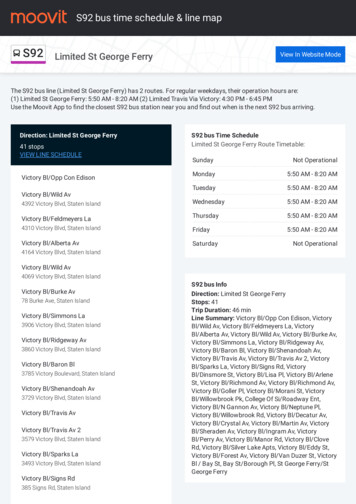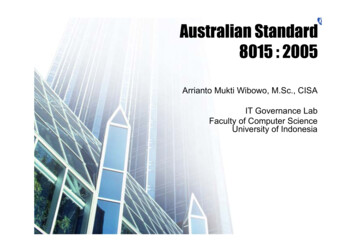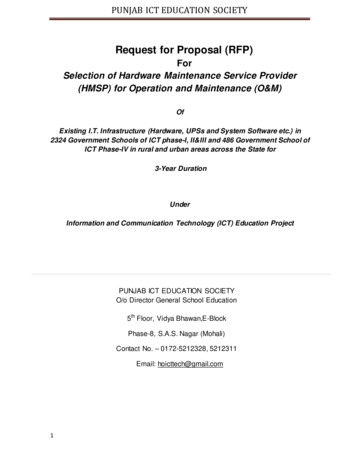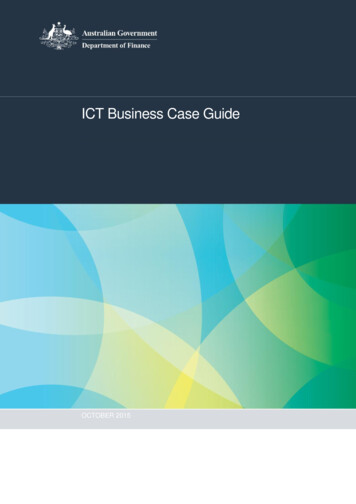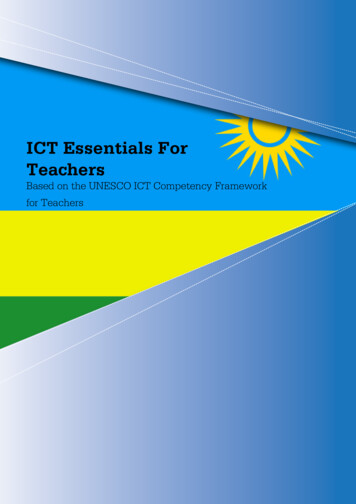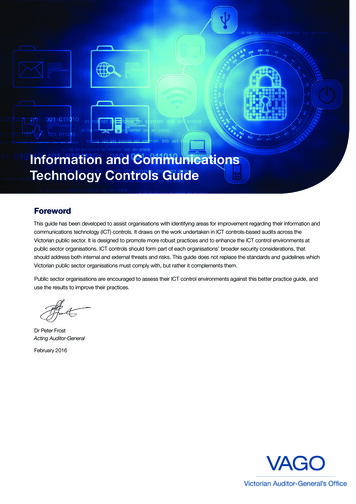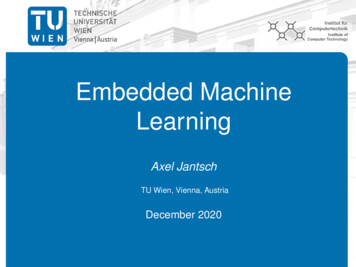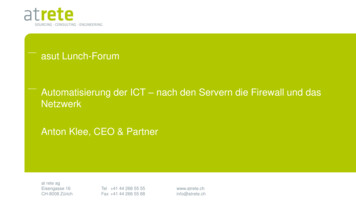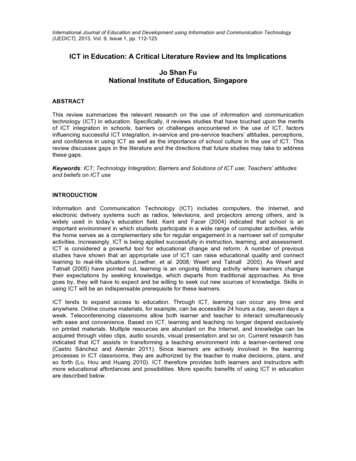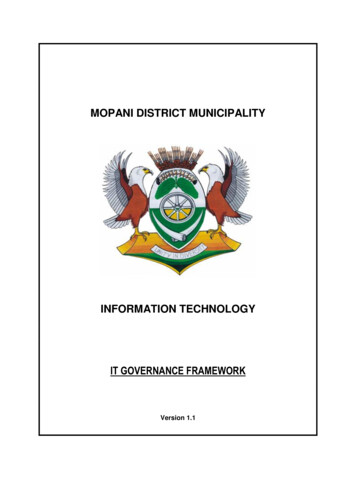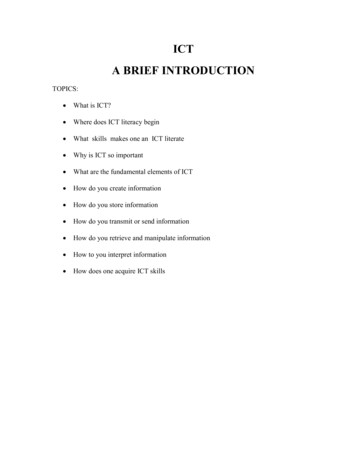
Transcription
ICTA BRIEF INTRODUCTIONTOPICS: What is ICT? Where does ICT literacy begin What skills makes one an ICT literate Why is ICT so important What are the fundamental elements of ICT How do you create information How do you store information How do you transmit or send information How do you retrieve and manipulate information How to you interpret information How does one acquire ICT skills
WHAT IS ICT?ICT is short for Information & Communications Technology.ICT covers all forms of Computer and Communications equipment as well as the softwareused to create, store, transmit, receive, interpret, and manipulate information in its variousformats.Information comes in various formats and it is all around us: Voice ConversationTextpicturesDataMotion Pictures or VideoMultimedia PresentationsRadio and Wireless BroadcastTelevision BroadcastICT deals with all the systems involved in creating, storing, sending or transmitting,receiving and manipulating these kinds of information.The systems behind ICT include both hardware devices and the software that allow thehardware devices to carry out or to be used for their intended functions.Hardware is the physical parts of the system that one can see and touch. For example theComputer’s CPU is a hardware aspect of the Computer system. The Computer’s Display orMonitor is another hardware component of the Computer system. For the Computer toperform its function there are programs or software aspects that work together with thehardware components to make the Computer usable.A Computer needs software to help create and manipulate information such as text, data,picture or video. To manipulate information such as print a document, the Computer needsto have a printer software running that can communicate with the printer (hardware). Theprinter software, also known as printer driver, tells the printer what to print, how to print andwhen to print it. Without this software you will not be able to print hard copies of yourdocument on paper.
WHERE DOES ICT LITERACY BEGIN?ICT know-how begins with Computer Literacy.Nowadays Computers can be found in a lot of places apart from individual homes.Computers are being used at workplaces, in schools, libraries and businesses to accomplish avariety of tasks at a fraction of the time that it took to accomplish those same tasks longbefore the introduction of Computers.Computers help us accomplish more in less time and more efficiently. Computers have madeus more productive than ever before.Being a Computer literate has become very important in the world these days. ComputerLiteracy enables people to acquire the basic skills and knowledge to be part of the workforcein any ICT equipped environment.Computer Literacy has created and continues to create many job opportunities for people.Skills in ICT provides opportunities for people to work with one another as well asindependently to undertake and accomplish different tasks.Thanks to developments in ICT you can now compose and send messages to friends andfamily as wells as to colleagues at work with the help of electronic mail applications and ICTnetworks such as the Internet.Text messaging to friends and families using various mobile devices has become the order ofthe day.Video Conferencing for important meetings across the globe is now possible.In summary the knowledge and use of Computers is at the core of ICT literacy and skillbuilding.WHAT SKILLS MAKES ONE AN ICT LITERATE?Information and Communications Technology (ICT) covers a wide range of systems andtechnologies and an individual does not need to know all these systems and technologies inorder to be considered as an literate.To be considered an ICT literate one needs to acquire various ICT skills that include but notlimited to the following:
Must understand and be able to use a Computer to perform various tasks such asopening applications, creating and modifying documents, spreadsheets orpresentations. Some basic typing skills will be necessary.Have the ability to identify various ICT technologies and their uses.Understand ICT technologies and concepts and be able to decide which ICTtechnology will be suitable for a particular task.Ability to differentiate between various forms of information and understand how touse or manipulate them.WHY is ICT important?Information and Communication Technology (ICT) is all around us. We encounter someelements of ICT in our day-to-day lives. In offices, schools, libraries, industries and homesICT is increasingly being used. It has become progressively more important to acquire skillsin ICT for several reasons.Acquiring skills, knowledge and understanding in the use of ICT systems prepares people touse such technologies to accomplish various tasks in their everyday lives as well as in theirworking lives.ICT technologies such as the Internet enables people to access and share information.Distant learning and online education has become the order of the day thanks toadvancements in ICT.The knowledge of ICT provides opportunities for people to work both collaboratively andindependently in completing different tasks.Companies are able to reduce cost of operations and improve efficiency by using the rightICT systems to conduct their businesses.With the appropriate ICT systems, information and data can be stored and retrieved moreefficiently and reliably.The application of ICT to accomplish tasks is not limited to any particular business orindustry. Whether you are a teacher, student, doctor, nurse, accountant, architect or engineerthere is a great chance that you are currently using Computers or will be doing so in the nearfuture to perform various duties in your field.What are the fundamental elements of ICTThe basic components of an ICT system include devices such as Computers andCommunications equipment and networks used to create, store, retrieve, send and receiveinformation.A Computer can be used to create, store or change information.
Communication devices such as modems, routers, switches and hubs that are connected toComputer systems help to transmit and receive information to and from other Computers andICT systems.Communication devices simply allow Computers and various ICT systems to be connectedto one another. They facilitate the transmission and receiving of information and data overthe transmission media that link them to each other.Examples of Transmission Media are: Cables (Copper or Fiber)Telephone LinesCellular or Mobile Links (through open space, wireless)Satellite Links (though open space)Communication devices and the infrastructure or transmission media that link them togetherconstitute Communication Networks.What are Communications Networks?In order to send and receive information you need some kind of infrastructure or network inplace to transport the information back and forth. This is the communications network.A Communications Network is made up of connected Communications devices and thetransmission media that link them together.The are various forms of communications networks: Local Area Networks Wide Area Networks The Internet Satellite Links Telephone NetworksThe Internet has become a major communications and information distribution network.Below are some illustrations of the above forms of Communication Networks:
LOCAL AREA NETWORKFile ServerDatabase ServerLaptopPC WorkstationEmail ServerLOCAL AREA NETWORKPC WorkstationPC WorkstationPC WorkstationPC WorkstationIn the Local Area Network (LAN) above any PC Workstation is able to retrieve or store fileson the file server. The workstations can also send electronic mail (email) to one anotherthrough the Email Server. Important data can be stored in records on the Database Server.
unicationCommLAN-A kLin nstioicaun mmCosLinkWIDE AREA NETWORK LAN-B Main OfficeBranch OfficeThe Wide Area Network is an expansion of the Local Area Network. In addition toinformation exchanges between Computers inside the same building, data transfers and emailcan now be transmitted over long distance across town, between two cites or even twocontinents.
THE INTERNETInternet ResourceINTERNETInternet ResourceWireless Access PointWireless LaptopRouter ModemThe Internet is the Network of Networks that has extended our global reach to resources allover the world.
A SIMPLE CELLULAR NETWORKMobile-AWireless LaptopMobile-BCell TowerMobile-CMobile-DHow do you create information?There are various ways to create information in its various forms.Depending on the kind of information being created one of the following methods can beused: A Word Processor such as Microsoft Word, Wordpad or OpenOffice Writer can beused to create documents.A program like Excel on the Computer helps to create spreadsheets.There are applications for creating presentation documentsVarious applications allow you to enter records in a databaseVideo recording device connected to a Computer (e.g. WebCam)Camera or Camcoder can be used to capture scenes or record videoMicrophone to create voice informationVideo editing applications to manipulate motion pictures or video
How do you store information?In ICT storing information means keeping the information on a reliable storage media sothat it can be retrieved and re-used when needed.Once created, information or data can be stored on any of the following media: The Computer hard disk A USB or Pen drive A writeable Compact Disk or CDROM A magnetic tapeHow do you retrieve and manipulate information?Depending on what ICT technology was used to create and store information, it can beretrieved and manipulated when necessary.You will always need a similar or compatible application to retrieve and manipulatedocuments and data created using a particular application.For example you will use a word processor to retrieve and view documents created with thesame application. Same concept applies to a spreadsheets and presentation documents.Using a windows application such as MSWord or Excel you can open an existing documentor file, view its contents, add more contents or change current contents. You can then saveyour changes to update the file.How do we transmit information from one place to another?Information can be transmitted from one place to another with the help of a Communicationsinfrastructure such as a Local Area Network or the internet. Many companies have their owninternal Networks ( LAN or WAN) equipped to facilitate information transfer.You can send information via electronic mail or by using various file transmissionapplications such as FTP. Files can be copied from one computer to another over a LocalArea Network, Wide Area Network or the Internet.Using the appropriate equipment and transmission media, information can be sent andreceived between two end points. For example with the help of a modem or routerconnecting your Computer to the Internet you can send electronic mail and text messages topeople around the globe.Documents and files can also be sent as attachments to electronic messages (emails).
What does interpreting information mean?Making sense out of information to be able to use it in accomplishing a particular taskAn ICT literate with the skills to create and manipulate an Excel spreadsheet also possessesthe knowledge to make sense of the spreadsheet that he or she creates as well as those that heor she receives or retrieves from other sourcesHow does one acquire ICT skills?A Computer literate is someone who has developed the skills to be able to use a Computer toaccomplish meaningful tasks as part of their normal duties in the workplace or in private.Most schools now have ICT and Computer studies as part of their curriculumBesides acquiring ICT knowledge and skills through formal education an individual can takesteps to develop skills on their own through one of the following means: Register for Computer training classesRegister for an online or internet training courseUse free Tutorials and Manuals on the InternetLearn to type with the help of typing software (.e.g Mavis Beacon Teaches Typing)Learn to identify various programs on the Computer and what they can be used forLearn to use the Computer to find information
ICT deals with all the systems involved in creating, storing, sending or transmitting, receiving and manipulating these kinds of information. The systems behind ICT include both hardware devi
